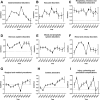Suspected adverse drug reactions of rivaroxaban reported in the United States food and drug administration adverse event reporting system database: a pharmacovigilance study
- PMID: 39309013
- PMCID: PMC11412890
- DOI: 10.3389/fphar.2024.1399172
Suspected adverse drug reactions of rivaroxaban reported in the United States food and drug administration adverse event reporting system database: a pharmacovigilance study
Abstract
Purpose: This study aimed to characterize the safety profiles of rivaroxaban-associated suspected adverse events by mining the Food and Drug Administration Adverse Event Reporting System (FAERS).
Methods: A disproportionality analysis of spontaneously reported suspected adverse drug reactions (ADRs) was conducted. The reports in FAERS from 2014 to 2024 were compiled. Frequentist and Bayesian statistics were both applied to calculate drug-AE combinations in system organ classes and preferred-term levels. Reporting odds ratio (ROR), proportional reporting ratio (PRR), the Medicines and Healthcare products Regulatory Agency (MHRA), Bayesian confidence propagation neural network (BCPNN), and multi-item gamma Poisson shrinker (MGPS) methods were analyzed and used to compare the suspected AEs.
Results: Of 77,384 ADR reports, 66,705 (86.20%) were serious rivaroxaban AE reports. The most common age group was above 65 years. The suspected adverse effects of rivaroxaban emerging for system organ classes (SOCs) primarily included "Gastrointestinal disorders"; "Injury, poisoning, and procedural complications", "Nervous system disorders" and "Vascular disorders". Ranked by EBGM, the top signal strength of suspected AE signals of rivaroxaban under ROR algorithm at the preferred-term (PT) level were "Haemorrhagic arteriovenous malformation" (N = 571, ROR = 756.520, PRR = 754.029, Information Component (IC) = 7.197, Empirical Bayesian Geometric Mean (EBGM) = 146.725), "Gastrointestinal vascular malformation haemorrhagic" (N = 197, ROR = 211.138, PRR = 210.950, IC = 6.614, EBGM = 97.923), and "Diverticulum intestinal haemorrhagic" (N = 722, ROR = 169.898, PRR = 169.210, IC = 6.458, EBGM = 97.920). Moreover, uncommon but significantly suspected AE signals, such as "Coagulation factor X level increased", "Basal ganglia haematoma", and "Proctitis haemorrhagic" were observed. Notably, "Gastrointestinal haemorrhage" (N = 13,436, ROR = 80.477, PRR = 74.460, IC = 5.729, EBGM = 53.042), "Upper gastrointestinal haemorrhage"(N = 2,872, ROR = 73.978, PRR = 72.797, IC = 5.706, EBGM = 52.198) and "Internal haemorrhage" (N = 2,368, ROR = 91.979, PRR = 80.899, IC = 5.813, EBGM = 56.212) exhibited relatively high occurrence rates and signal strengths. From 2014 to 2024, the IC values of rivaroxaban-associated suspected AEs for "Surgical and medical procedures" and "Cardiac disorders" showed an annual increasing trend in the time-span analysis. Based on the various visulization plots, a key discovery is that "Gastrointestinal hemorrhage" emerged as the most significant suspected AE across five algorithms. The exciting finding was that the MGPS algorithm revealed a higher risk of suspected AEs under the "Investigations" category. However, the results of the analyses of the other algorithms at the SOC level were not akin to this. Moreover, the results of signal mining for the three main types of indication populations with adverse drug reactions (ADRs), including Atrial fibrillation, Cerebrovascular accident prophylaxis, and Deep vein thrombosis were shown that "Gastrointestinal haemorrhage", "Epistaxis", "Haematuria", "Rectal haemorrhage", and "Upper gastrointestinal haemorrhage" were detected as the most common and significant signals of suspected adverse events.
Conclusion: Rivaroxaban has risks of various suspected adverse reactions while providing therapeutic effects and being used widely. Our pharmacovigilance study may provide valuable hints that practitioners should closely monitor occurrences of "Gastrointestinal disorders", "Injury, poisoning, and procedural complications" and "Nervous system disorders", and other events in clinical applications. Consequently, it remains to persist in monitoring rivaroxaban, assessing the associated risks in the future.
Keywords: disproportionality analysis; drug safety; pharmacovigilance; rivaroxaban; suspected adverse event.
Copyright © 2024 Wu, Wu, Tang, Wang, Wei, Zhang, Li, Li, Wang, Wu and Hong.
Conflict of interest statement
The authors declare that the research was conducted in the absence of any commercial or financial relationships that could be construed as a potential conflict of interest.
Figures






Similar articles
-
A pharmacovigilance study of vortioxetine based on data from the FDA adverse event reporting system.Sci Rep. 2025 Aug 7;15(1):28886. doi: 10.1038/s41598-025-13786-7. Sci Rep. 2025. PMID: 40775011 Free PMC article.
-
A disproportionality analysis of low molecular weight heparin in the overall population and in pregnancy women using the FDA adverse event reporting system (FAERS) database.Front Pharmacol. 2024 Aug 12;15:1442002. doi: 10.3389/fphar.2024.1442002. eCollection 2024. Front Pharmacol. 2024. PMID: 39188956 Free PMC article.
-
A pharmacovigilance study on probiotic preparations based on the FDA Adverse Event Reporting System from 2005 to 2023.Front Cell Infect Microbiol. 2025 May 13;15:1455735. doi: 10.3389/fcimb.2025.1455735. eCollection 2025. Front Cell Infect Microbiol. 2025. PMID: 40433664 Free PMC article.
-
Romosozumab adverse event profile: a pharmacovigilance analysis based on the FDA Adverse Event Reporting System (FAERS) from 2019 to 2023.Aging Clin Exp Res. 2025 Jan 14;37(1):23. doi: 10.1007/s40520-024-02921-5. Aging Clin Exp Res. 2025. PMID: 39808360 Free PMC article.
-
Adverse drug reactions related to methotrexate: a real-world pharmacovigilance study using the FAERS database from 2004 to 2024.Front Immunol. 2025 Jun 4;16:1586361. doi: 10.3389/fimmu.2025.1586361. eCollection 2025. Front Immunol. 2025. PMID: 40534848 Free PMC article. Review.
Cited by
-
Signal mining for non-bleeding adverse event in novel oral anticoagulants: a pharmacovigilance study based on FAERS database.Naunyn Schmiedebergs Arch Pharmacol. 2025 Aug 13. doi: 10.1007/s00210-025-04501-4. Online ahead of print. Naunyn Schmiedebergs Arch Pharmacol. 2025. PMID: 40802006
-
Relationship between thromboembolic events and thrombopoietin receptor agonists: a pharmacovigilance analysis of the FDA Adverse Event Reporting System and the Japanese Adverse Drug Event Report.BMJ Open. 2025 Aug 10;15(8):e099153. doi: 10.1136/bmjopen-2025-099153. BMJ Open. 2025. PMID: 40784768 Free PMC article.
References
-
- AG. BP (2016). Xarelto1 summary of product characteristics. Available at: https://www.ema.europa.eu/en/documents/product-information/xarelto-epar-... .
LinkOut - more resources
Full Text Sources
Research Materials

